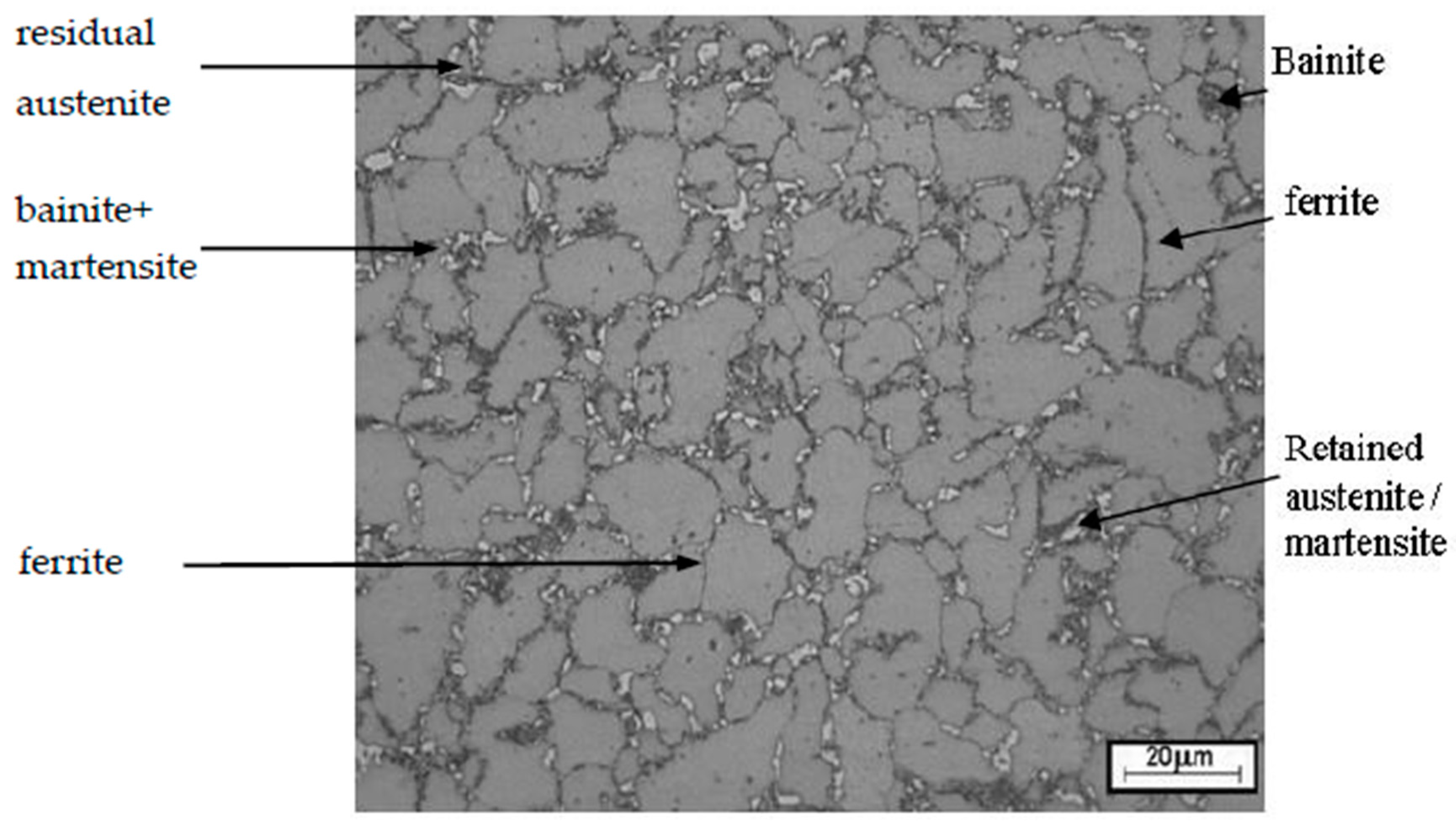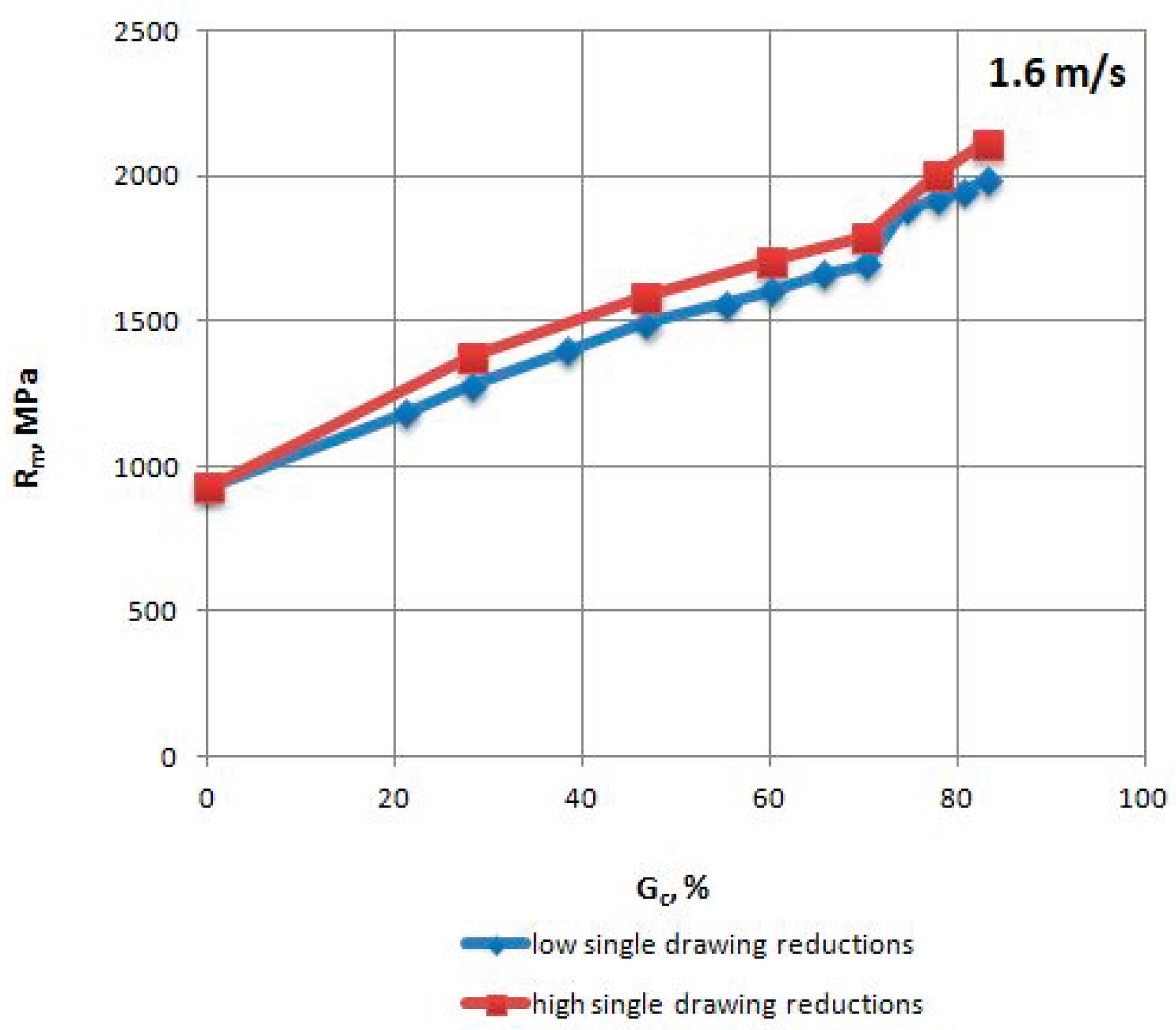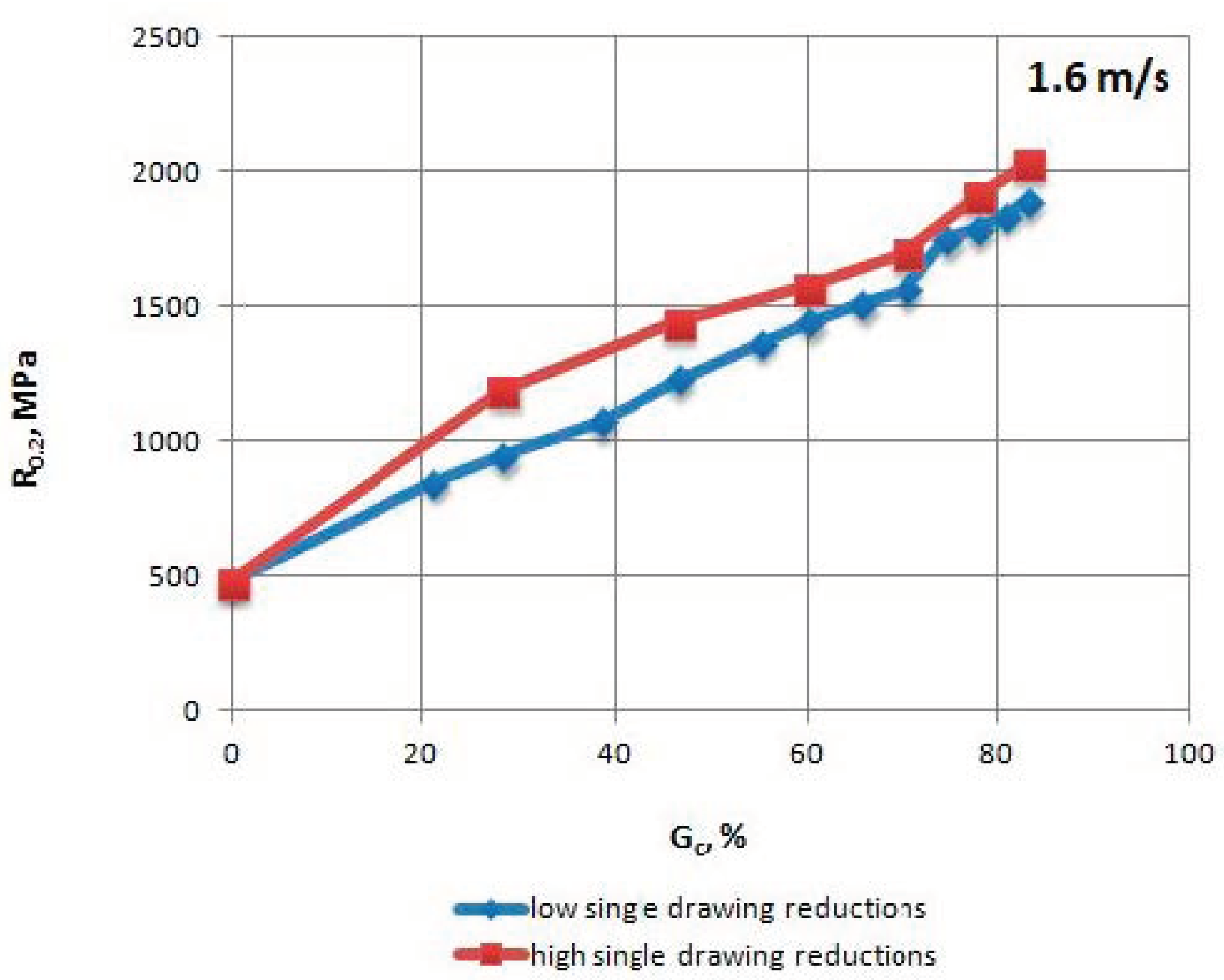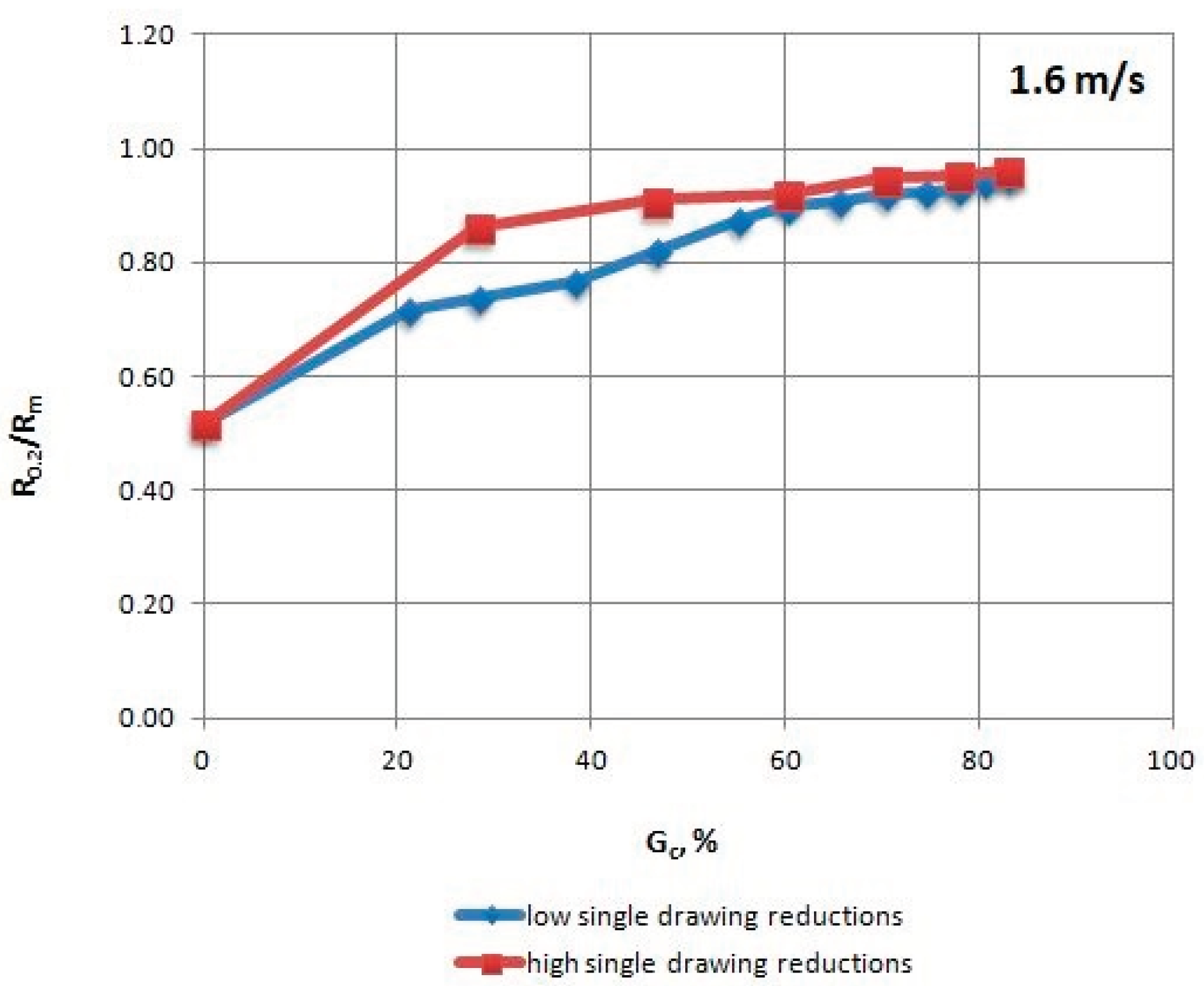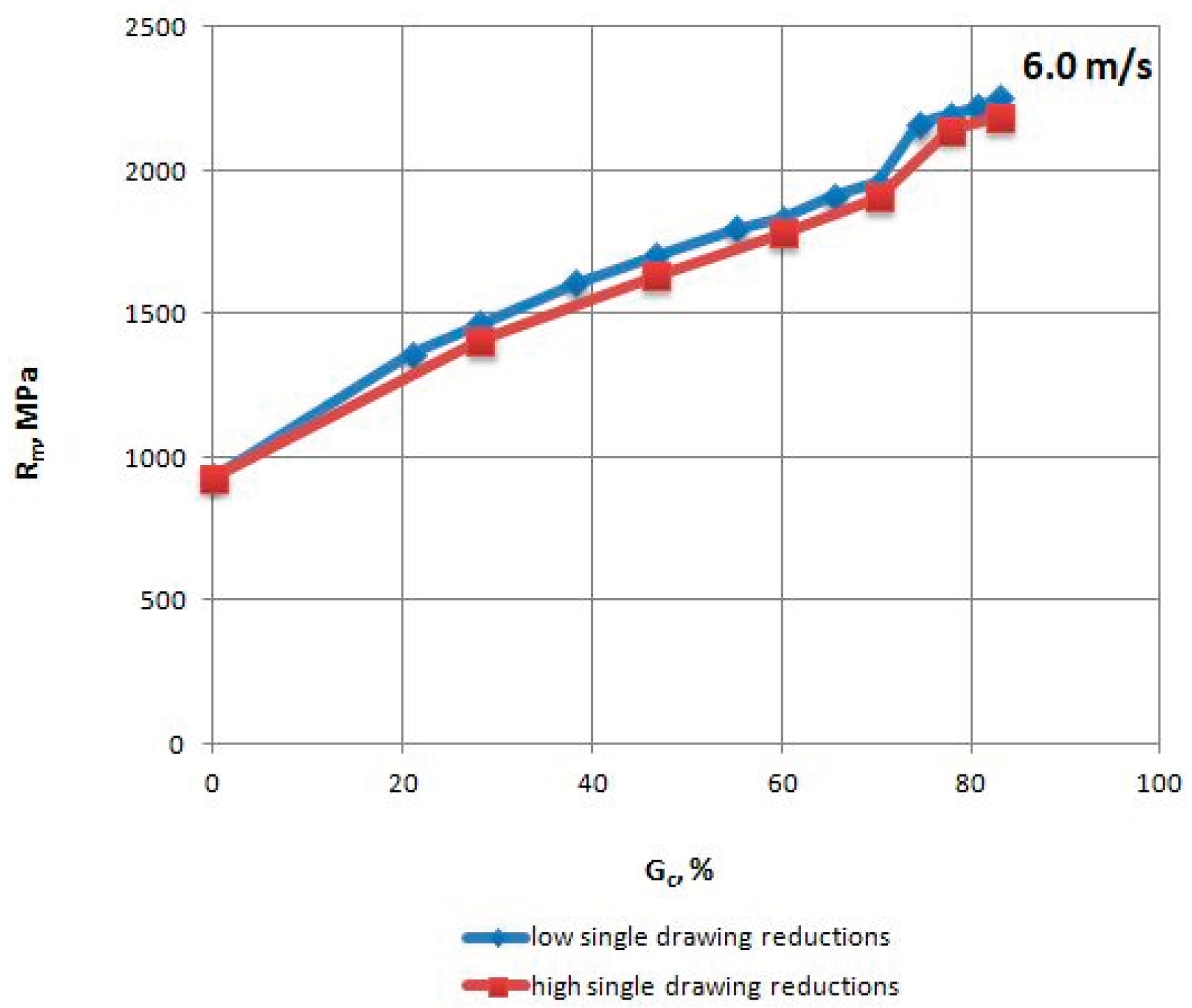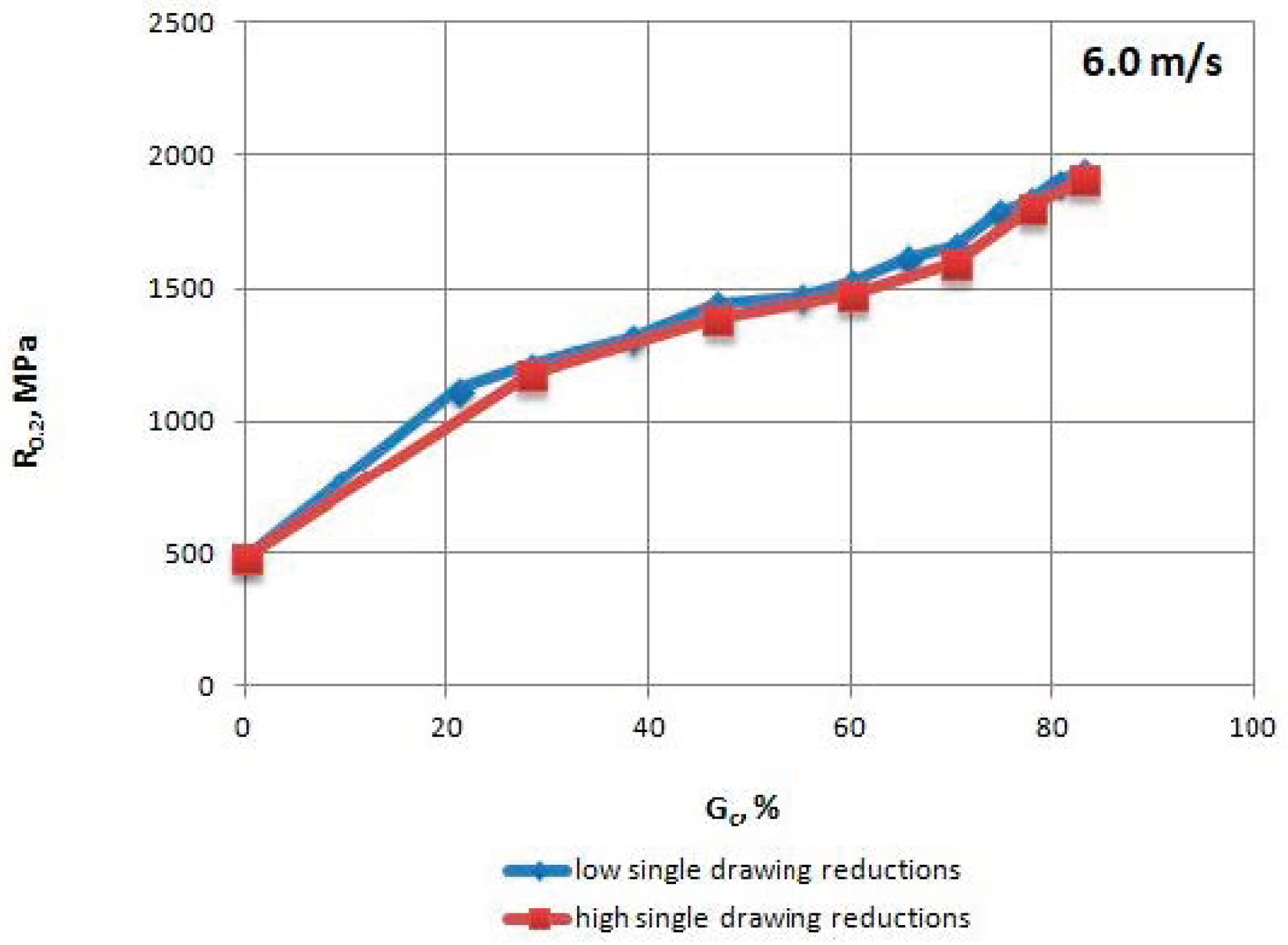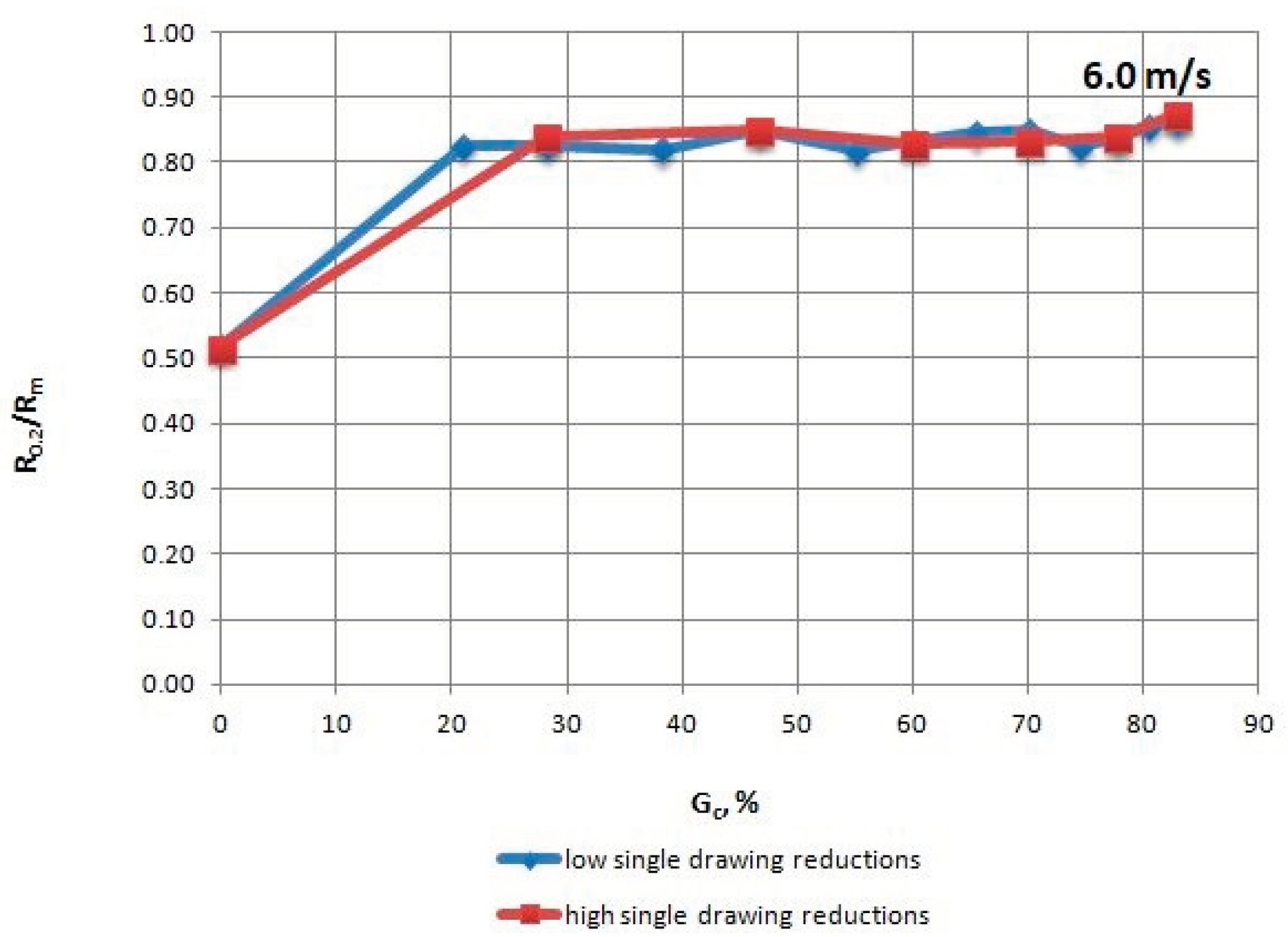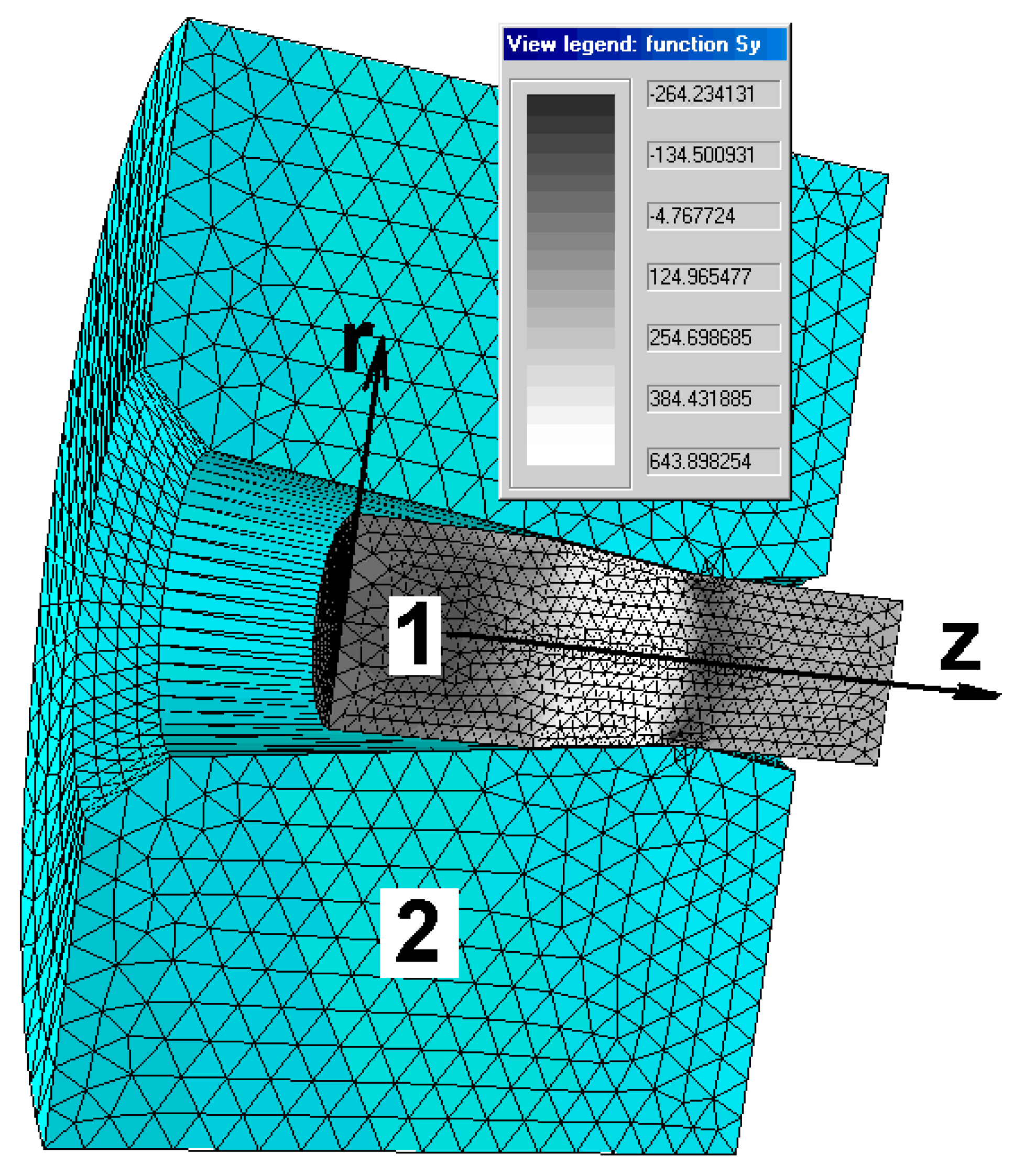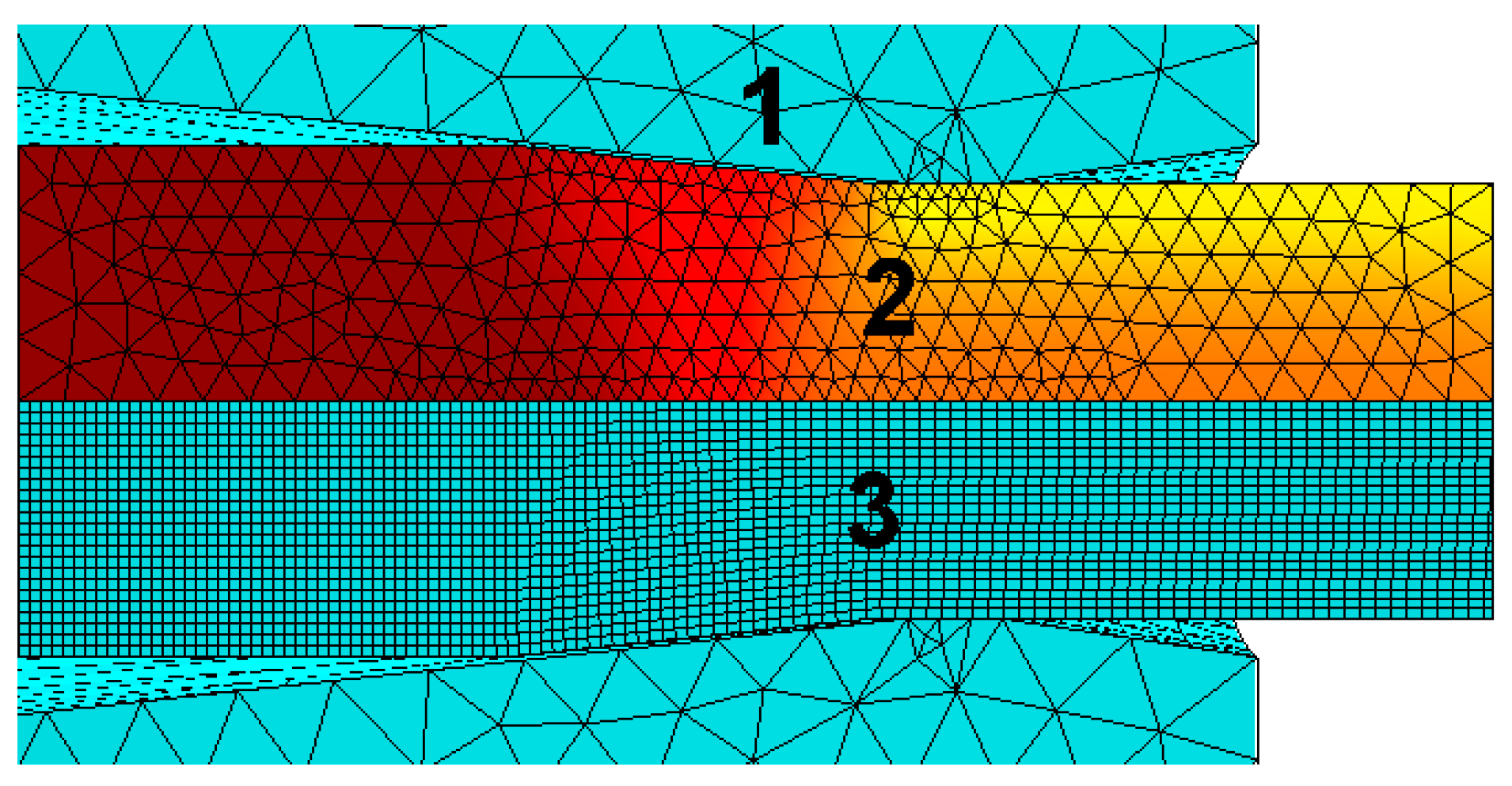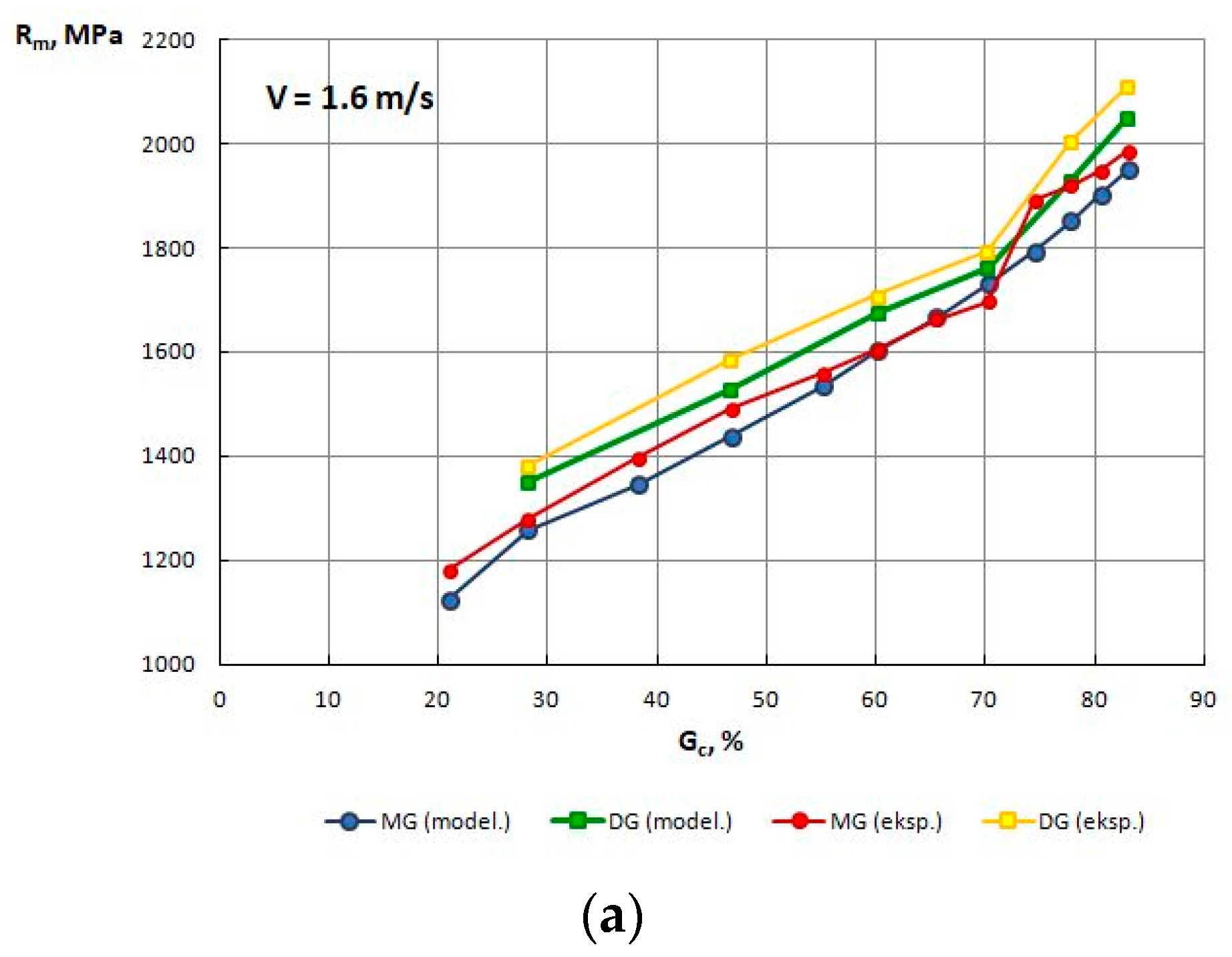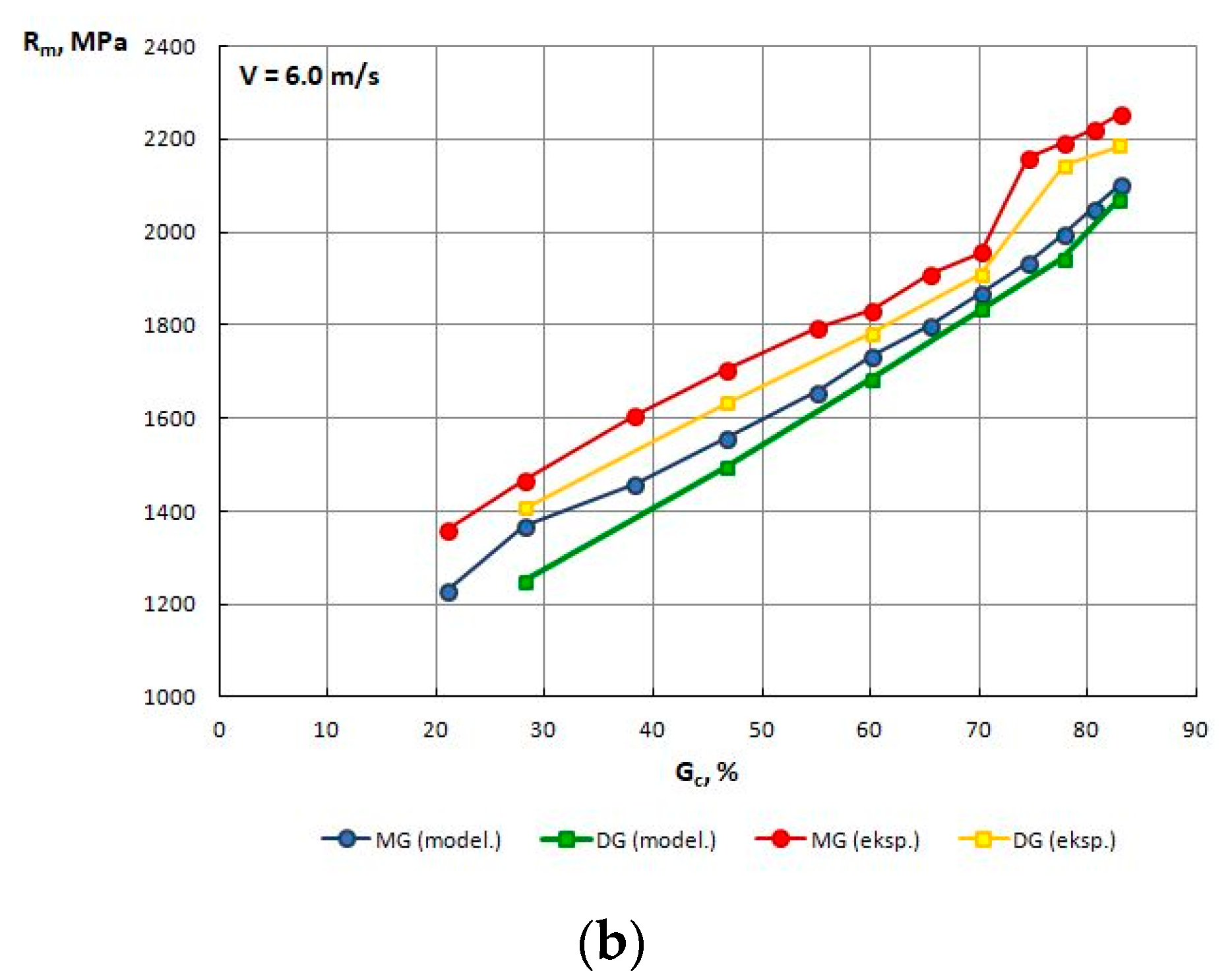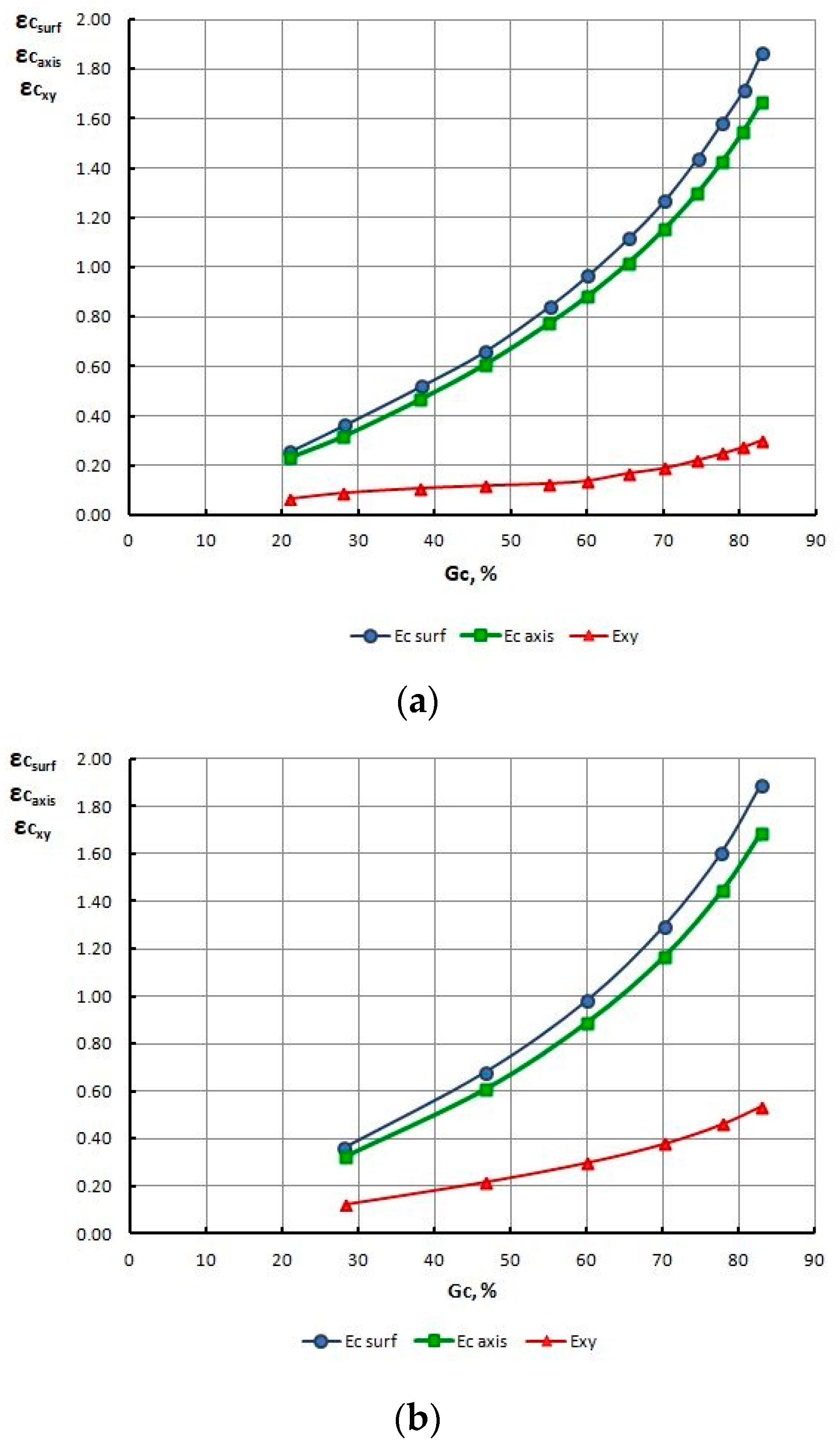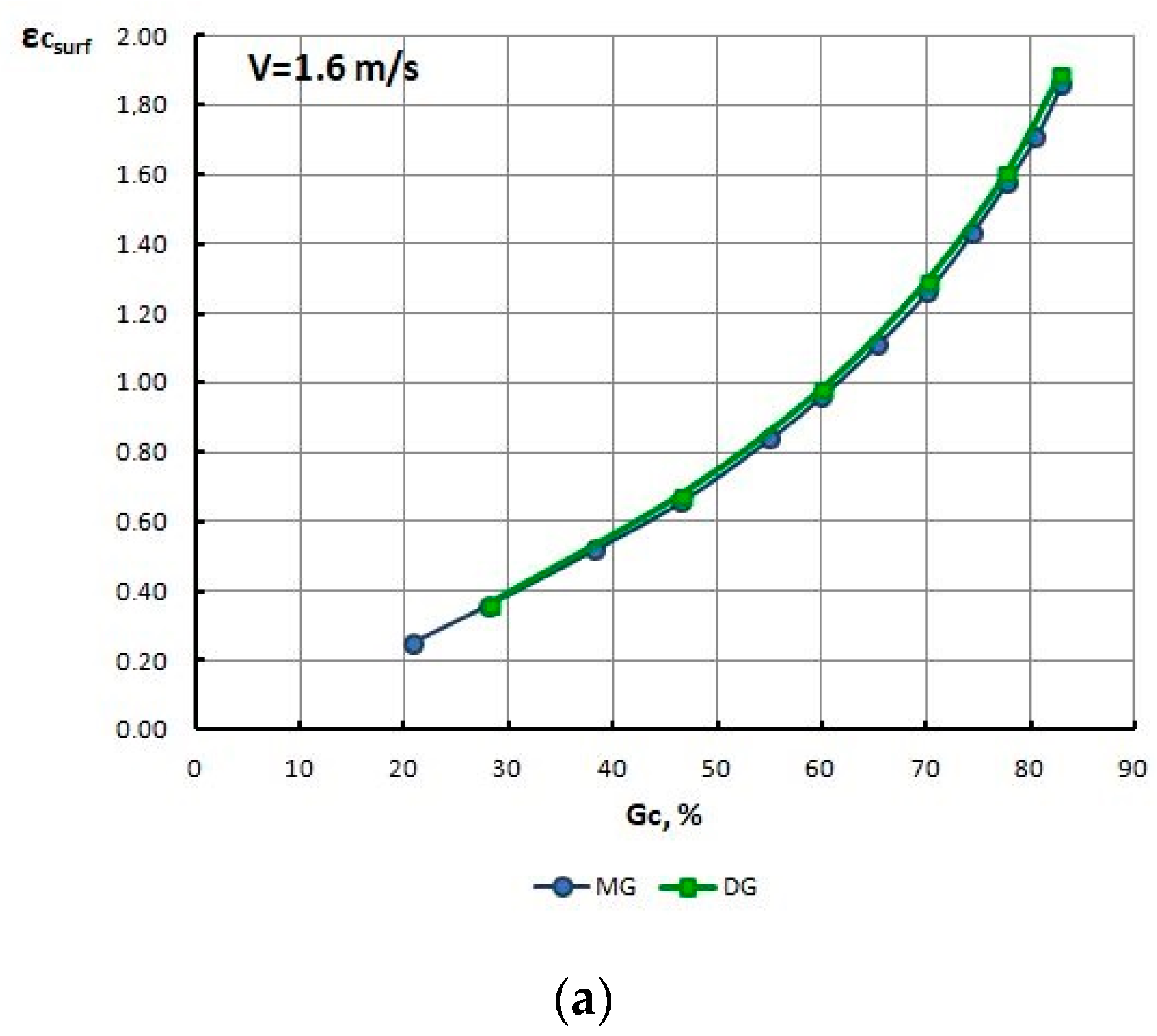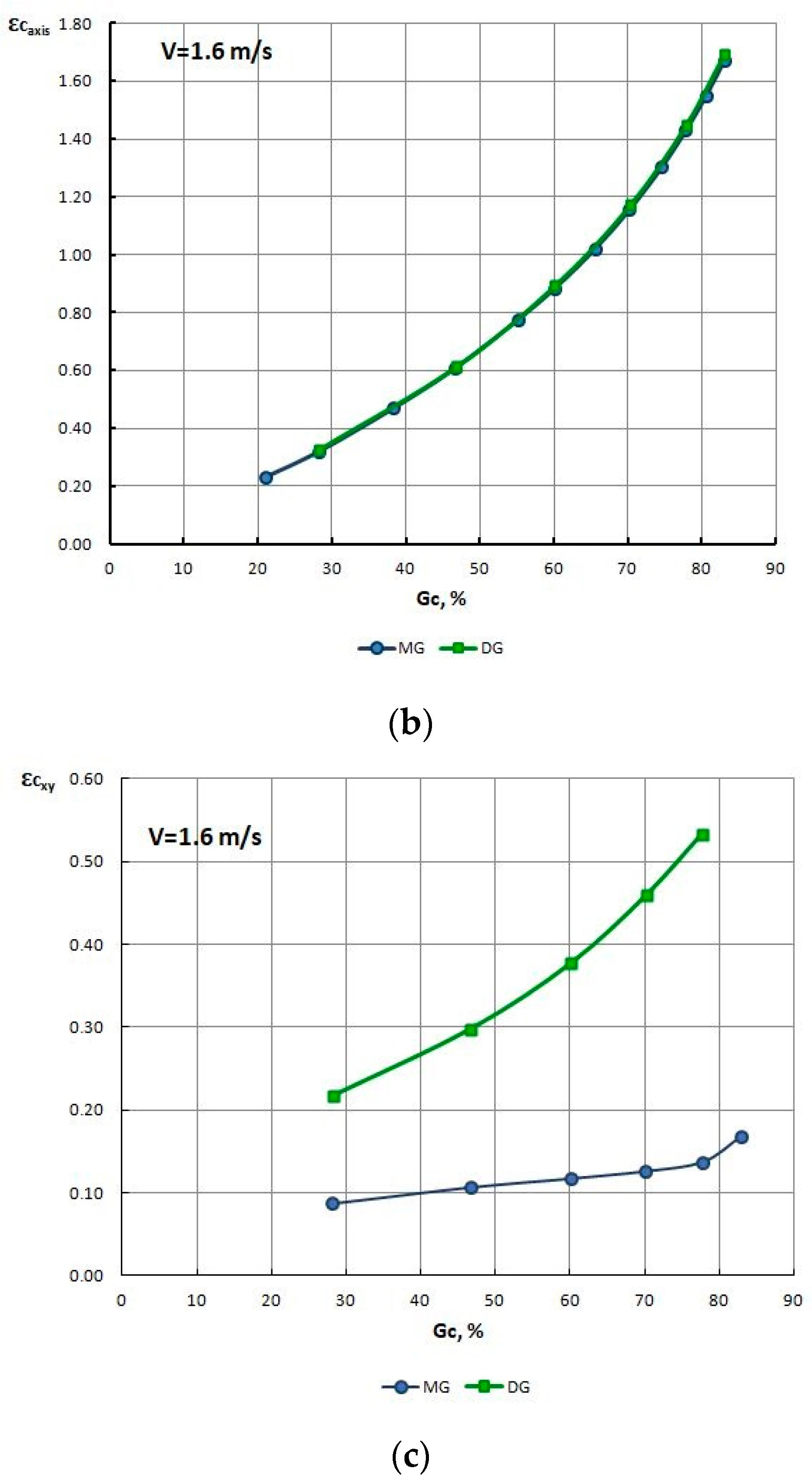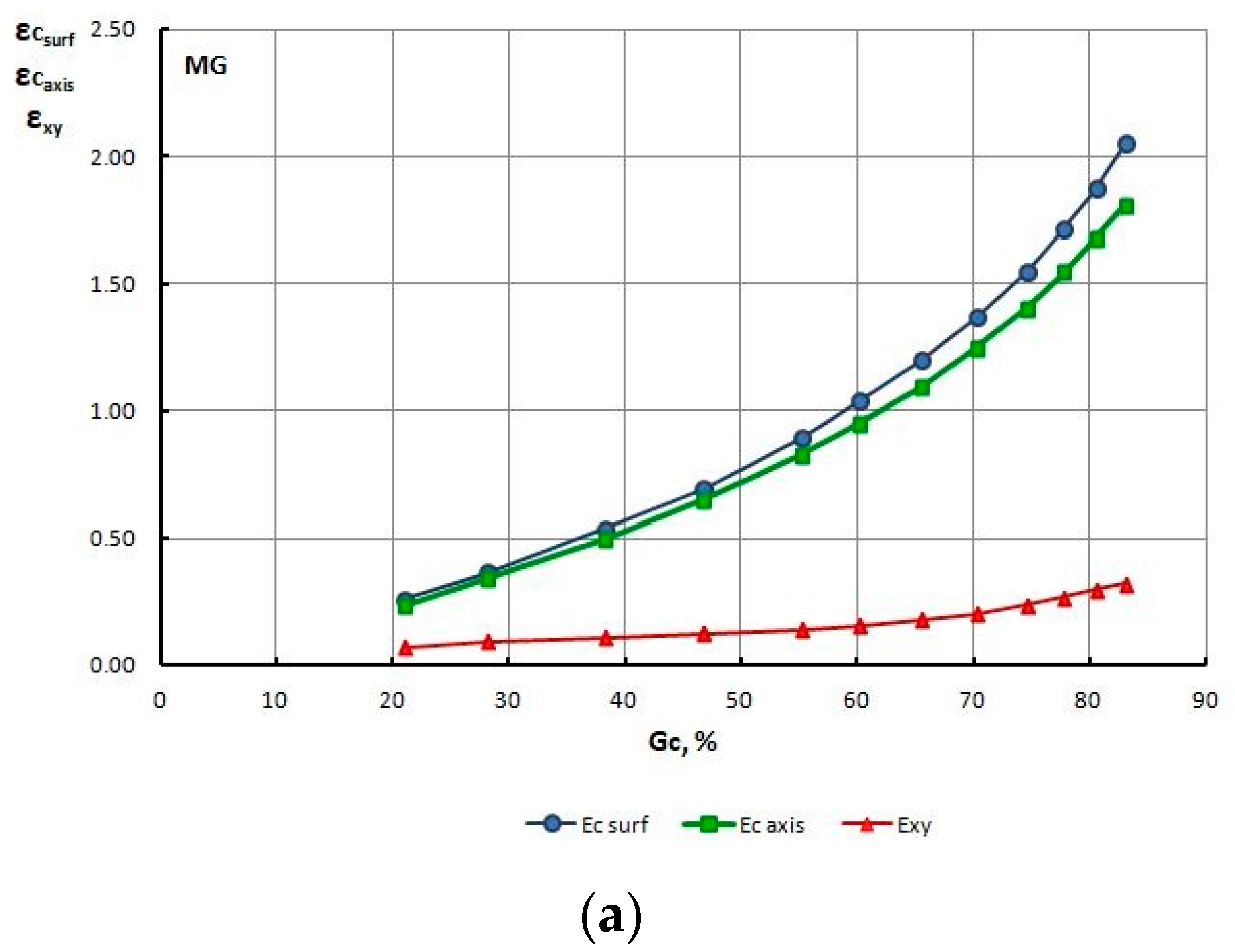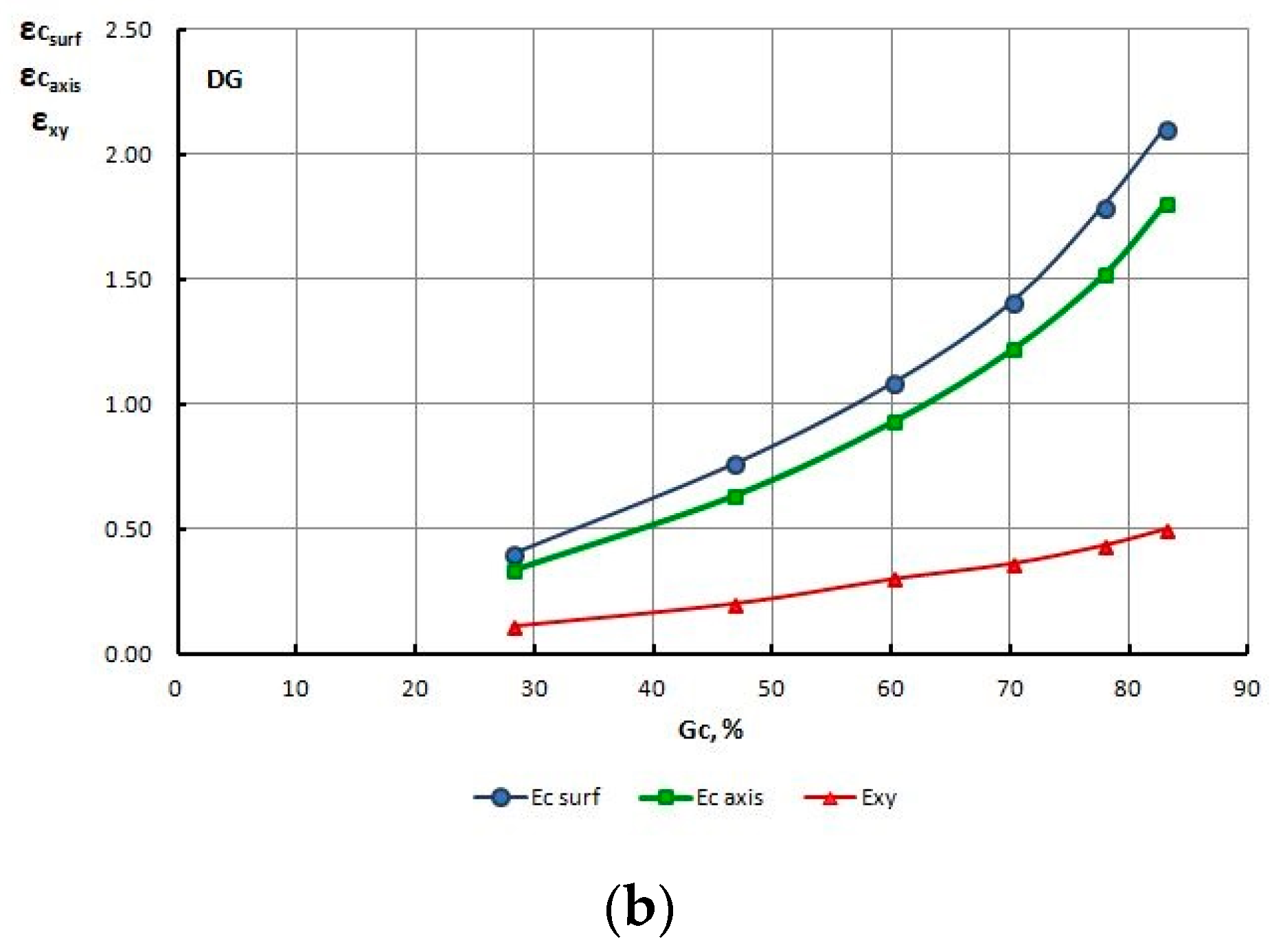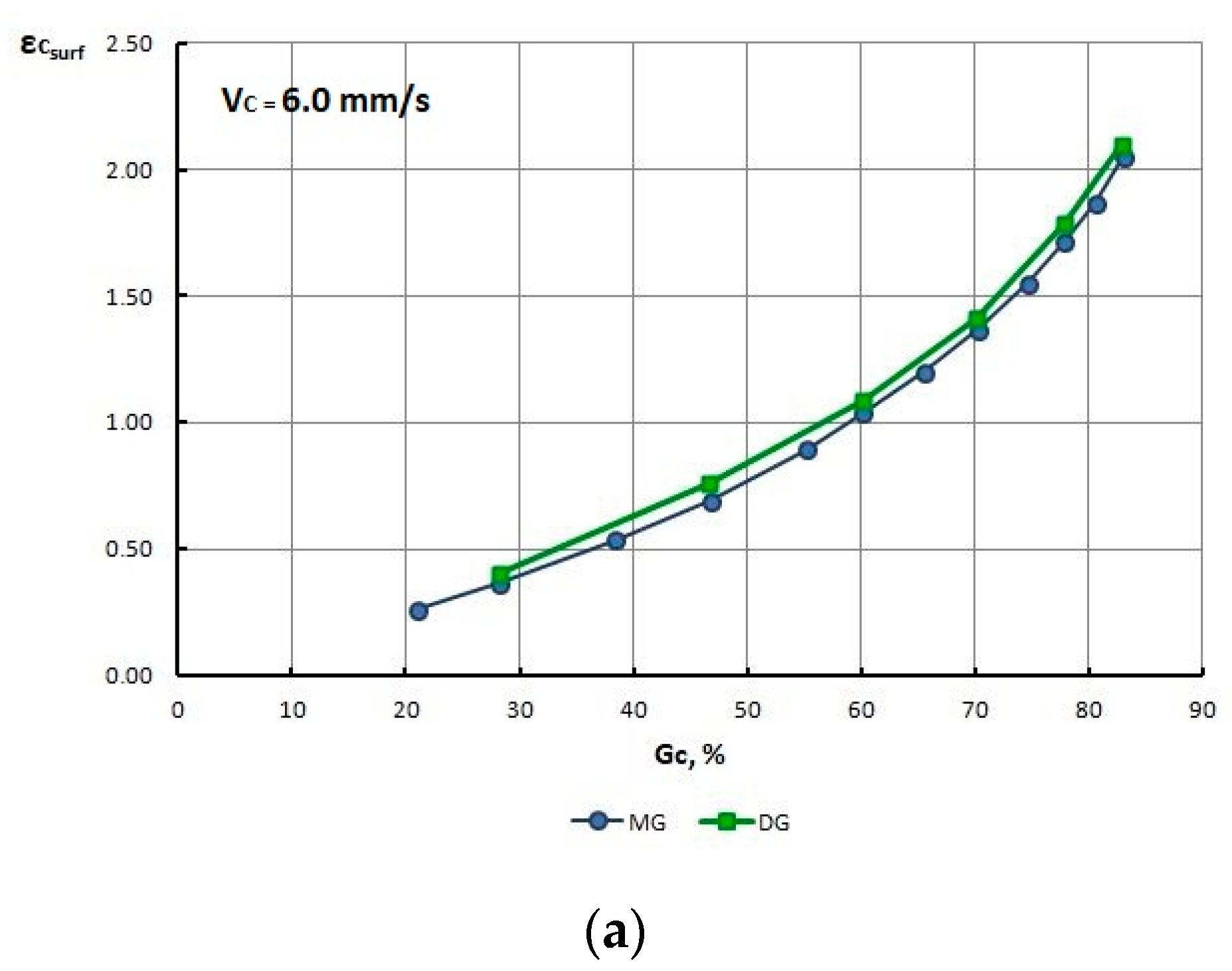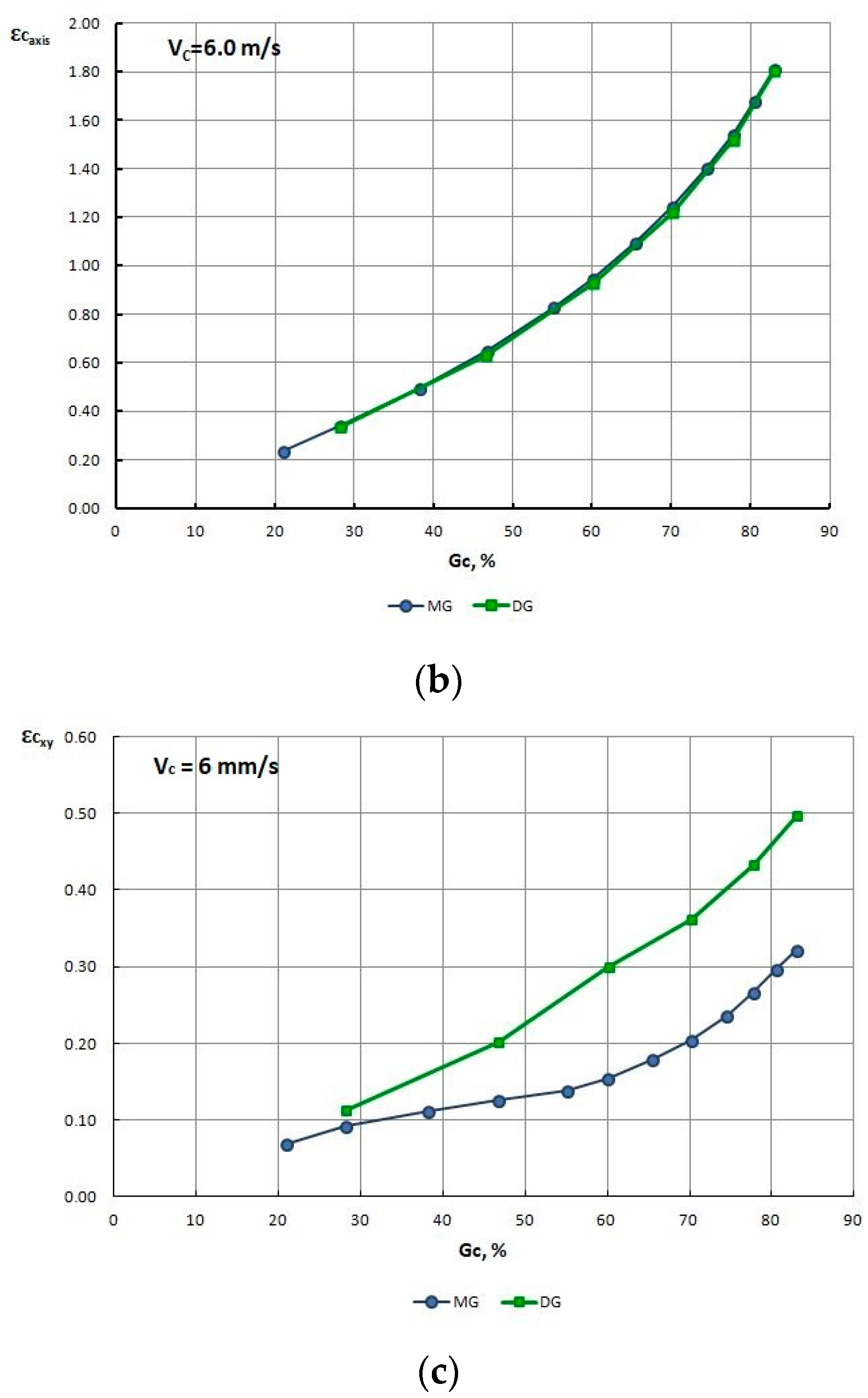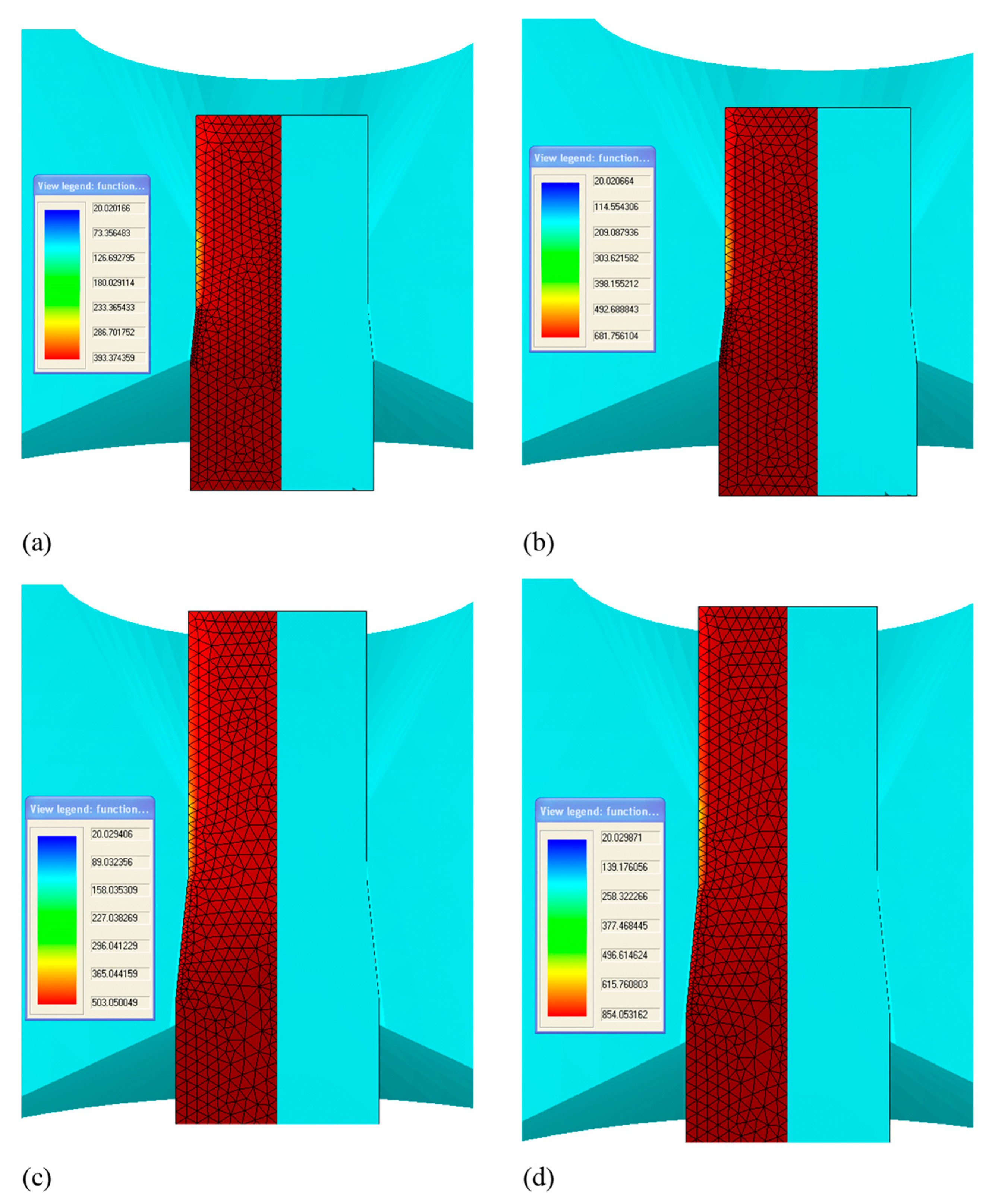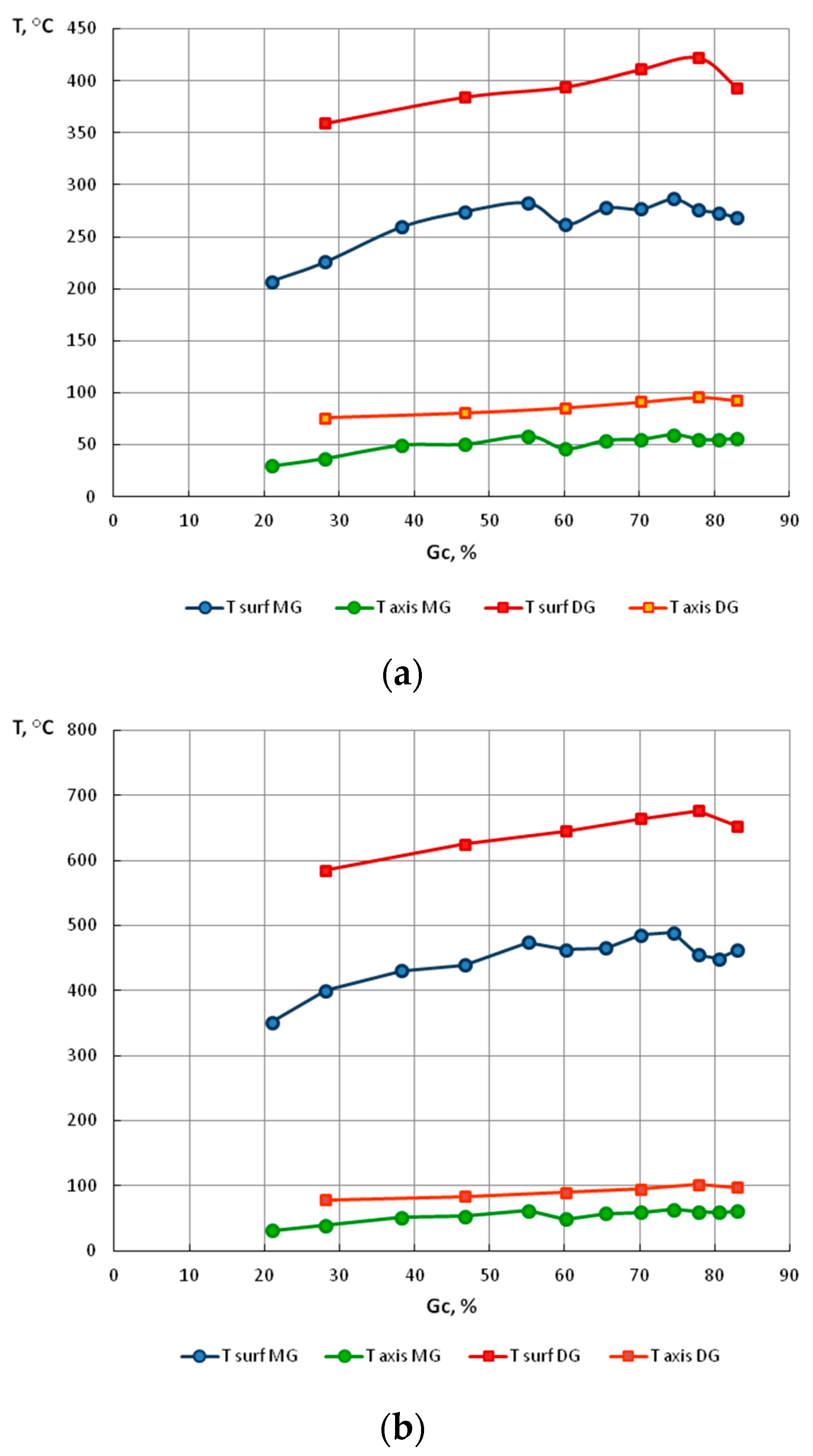1. Introduction
Significant progress in metallurgical technologies allows the production of different grades of steels from typical ferritic steels to multiphase high-strength steels, which are new materials having high mechanical properties while retaining very good plastic properties. An example of this type of materials is TRIP steels, which are currently used in the automotive industry for car body sheet in the controlled crash zone construction. TRIP steels are classified into the group of advanced high strength steels, which are distinguished by very high mechanical properties (above 700 MPa, reaching even 2000 MPa) and the percentage elongation being contained in a fairly wide range from 5 to 30%. Many publications concerned with the TRIP effect, the technology of producing TRIP steel sheet and its applications were found to exist in available literature; however, there were no publications concerning the technology of producing wire rod of low- and medium-carbon TRIP-structure steels and research on the drawing process and properties of wires of this type of steel. Therefore, in 2005, a team of researchers from the Drawing Engineering and Metal Products Department at the Czestochowa University of Technology, which included the authors of this paper, undertook studies on this subject matter, as the first on the global scale [
1,
2,
3,
4,
5,
6,
7,
8].
A factor determining the advantageous properties of the TRIP steel is the retained austenite contained in its structure, which undergoes a transformation into martensite during plastic deformation; this phenomenon is termed the transformation induced plasticity (TRIP) effect [
9,
10,
11]. The martensitic transformation may occur under the influence of stresses, strains or temperature [
12].
Multiphase TRIP structure containing ferrite, bainite, and retained austenite we can obtain by carrying out two-stage heat treatment process which consisted of holding the steel within the dual-phase austenitic–ferritic range with subsequent soaking it within the bainitic transformation range.
Studies reported in the literature show that for low-carbon steel (to 0.1% C), it possible to obtain from 8 to 10% of retained austenite [
13]. Limiting carbon content for TRIP steel oscillates around the 0.4% value because the increased volume fraction of carbon content can lead to excessive stabilization of retained austenite, which can contribute to the blocking transformation of retained austenite, which decides about the TRIP effect.
According to De Cooman [
14], the carbon content for TRIP steel can oscillate about values from 0.12 to 0.55%. Jacques and others stated that the steel with TRIP effect should have carbon content from 0.1 to 0.4% [
15].
The TRIP steels with high retained austenite content, which undergo martensite transformation gradually, with strain increasing, are characterized by the best mechanical properties. This is the effect of presence in steel structure the mechanical stable retained austenite, which extends the plasticity range of material, and martensite obtained after transformation, influences on the increase of the mechanical properties.
In this work, the analysis of the influence of the parameters of the drawing process (drawing speed and the value of using single reductions) on the mechanical properties of drawn TRIP steel wires was carried out during experimental work. The research was conducted for TRIP steel with 0.43% of carbon content and with a high amount of retained austenite in the structure obtained after a two-step heat-treatment process.
In order to explain the atypical phenomenon of the increase in the mechanical properties of drawn wires with low single reductions in relation to wires drawn with high single reductions, a theoretical analysis of the drawing process was carried out.
4. Tests Involving the Mechanical Properties of TRIP Steel Wires Drawn with Various Process Parameters
The mechanical properties of TRIP steel wires were tested according to different variants drawing process described in
Table 1 after each draw. The research was conducted according to Polish standard PN-EN ISO 6892-1:2010 [
17], on a ZWICK/Z100 testing machine (Zwick Roell Polska Sp. z o.o. Sp. K., Wrocław, Poland). The results are shown in
Table 4,
Table 5,
Table 6 and
Table 7 and
Figure 2,
Figure 3,
Figure 4,
Figure 5,
Figure 6 and
Figure 7.
Based on the test results shown in
Figure 2 and
Figure 3, it can be concluded that for a drawing speed of 1.6 m/s, the mechanical properties of wires (R
m and R
0.2) drawn with high (approx. 25.5% on average) single drawing reductions are higher (after all process stages) than the properties of wire draw with low (approx. 13.7% on average) single reductions.
This phenomenon is typical when drawing wires with different single drawing reductions since when the value of single cross-section decrements increases in individual draws, the Rm of the wires also increases. This results from the greater strengthening of the material caused by increased non-dilatational strain in the subsurface layer of the wires.
When analyzing the change in the R
0.2/R
m coefficient (
Figure 4), higher plasticity of the wires drawn with low single reductions can be observed relative to wires with high single reductions, especially in the range of 20–50% of the total drawing reduction, when the difference reaches 19%.
Presumably, this is due to the fact that the speed of transformation of retained austenite into martensite is proportional to the strain level within a given draw, which is why a wire drawn with a single low reduction maintains larger quantities of retained austenite in its structure, which ensures its greater plasticity.
When analyzing the mechanical properties of wires drawn with different single cross-section decrements, at a drawing speed of every stage of Vc = 6.0 m/s, it was concluded that both R
m (
Figure 5), as well as R
0.2 (
Figure 6), is higher for wires drawn with low single drawing reductions, relative to the ones drawn with high single reductions. It was also found that in the case of the 0–25% range of the total drawing reduction, there was a more rapid reduction in the plasticity (R
0.2/R
m) of wires drawn with low single drawing reductions (
Figure 7).
This phenomenon contradicts the theory and technology of drawing steel wires with a typical ferritic-pearlitic structure; therefore, it must be associated with the TRIP structure of drawn wires and the transformation of austenite into martensite ongoing therein during heat treatment, which depends on the strain level and speed.
It was decided to conduct a theoretical process analysis in order to explain this phenomenon.
5. Drawing Process Theoretical Analysis
The theoretical analysis of the process of drawing TRIP steel wires was conducted using Drawing 2D software (version 2), which processes data based on the finite element method (FEM) [
18].
Boundary conditions corresponding to the conditions encountered during experimental tests were assumed for the numerical simulation. Modeling was executed for the speeds of 1.6 and 6.0 m/s using low and high single drawing reductions shown in
Table 1.
The drawing process was analyzed using classing conical dies with an angle of 2α = 12°. In the experimental analysis, TRAXIT CCF grease (Traxit Internatiional GmbH, Schwelm, Germany) was used as a lubricant in the drawing process, which reflects the semi-dry friction conditions.
Therefore, in numerical analysis, the value of friction coefficient (µ) between tool and material was estimated to 0.07.
The initial material temperature was 20 °C. The body deformation model was developed for the axial-symmetrical process and the conditions of the nonisothermic flow of an inaccuracy, rigid-plastic medium with nonlinear strengthening.
It is assumed that the friction conditions of Amontons–Coulomb are met on the surface of the die and wire. The contact and friction conditions between the material and the tool were modeled using the penalty function method.
Modeling such a process required a boundary task solution from the field of plastic processing theory taking into account heat flow, material heating from plastic deformation and friction, and transmission of data on material properties from string-to-string.
In the program, during calculations according to this model, a system was introduced that automatically generates a mesh of finite elements for each string and takes into account the dimensions of the tool and material (entered by the user of the program) [
18]. Isoparametric triangular finite elements were applied to the mesh (
Figure 8).
The heat model was considered a quasi-static problem.
When solving the heat task, the passage of the separate section of material through the thrust drawing cone, step-by-step, with the solution of subsequent part-time tasks at each step of the transition, was considered.
Lagrange’s rectangular mesh is also generated to visualize character strains in order to make the process easier to analyze. The displacement of each node of this mesh is calculated from the deformation of the “working” triangular mesh (
Figure 9).
To determine the rheological model of the material that was introduced into the program database, plasticometric studies were conducted on the Gleeble 3800 thermomechanical simulator (Dynamic Systems Inc., El Segundo, CA, USA). The studies were conducted for four deformation speeds: 5.0 s−1, 70 s−1, 150 s−1 and 240 s−1, at four temperatures of 20 °C, 200 °C, 400 °C and 800 °C.
In order to obtain a mathematical relationship that makes the yield stress value (
) dependent on deformation parameters,
the results of the tests were approximated with the functional relationship specified by Henzel-Spittel [
19], presented by Equation (1). The function parameters can be found in
Table 8.
The function parameters (1) in
Table 8 were used in the computer simulation of the drawing process. Drawing 2D software, in addition to the ability to read the values of individual parameters from the nodes of the finite element mesh, also calculates the average value of Rm (for the entire wire cross-section) over individual strings. Therefore,
Table 9 and
Figure 10 show the tensile strength of the wires (drawn with different process parameters) obtained from the simulation and compared them with the Rm values obtained from the experimental tests presented in the previous chapter. The standard deviation of tensile strength values obtained from the experiment and theoretical analysis is around 10 MPa.
Based on the tests shown in
Table 9 and
Figure 10, it can be concluded that modeling results exhibit a good correlation with experimental results (generally, differences below 10%), which proves the correct rheology of the material entered in the Drawing 2D software.
The numerical modeling results also confirmed that for the drawing speed Vc = 6.0 m/s, the Rm in wires drawn with high single reductions was lower than the Rm in wires drawn with low single reductions.
The surface temperature of the wire rises sharply along the length of the die working cone of the die. This is due to the heat release of plastic deformation and friction. In the gauging cylinder of the die, we still observe a slight increase in the temperature of the wire caused by friction, while after exiting the die, the temperature of the wire drops.
The material temperature in the wire axis increases quite quickly along the length of the working cone of the die and stabilizes in the gauging cylinder of the die. This is due to the fact that the material temperature in the wire axis is not directly influenced by the heat generated by friction on the contact surface of the die and wire. After the wire exits the die, the temperature of the material along the axis begins to increase as the temperature equalizes between the surface and axis of the wire, which is caused by thermal conductivity.
Significant temperature differences between the surface of the wire and its axis result not only from the heat associated with friction on the surface but mainly from the nonuniform deformation, i.e., unnecessary non-dilatational strain occurring outside the axis of the material and increasing from the axis to the surface of the wire.
In order to explain this phenomenon, for all drawing variants, the authors determined the strain level and the temperature on the surface and within the axis of wires, and non-dilatational strain (redundant) on the wire surface, at the output from the gauging cylinder of the die, reading the values from these parameters from finite element mesh nodes. The test results are presented in
Table 10 and
Figure 11,
Figure 12,
Figure 13,
Figure 14,
Figure 15 and
Figure 16.
Sample temperature distributions for final wires drawn according to different variants, obtained through modeling are shown in
Figure 15.
Based on the numerical modeling results shown in
Table 10 and
Figure 11,
Figure 12,
Figure 13 and
Figure 14 it can be concluded that for a drawing speed of both V
c = 1.6 m/s, as well as V
c = 6.0 m/s, the strain level on the wire surface ε
c surf is significantly higher than ε
c along their axis. However, no significant impact of the magnitude of single drawing reductions (MG and DG) on the change of these parameters was found (
Figure 12 and
Figure 14).
The numerical analysis of the drawing process, involving various parameters, also showed that for the process of wire drawing conducted with the scheme using large single drawing reductions, the non-dilatational strain on the wire surface after the last draw is almost twice as high as after drawing with low single drawing reductions.
However, no influence of the drawing speed on the course, as well as the value of non-dilatational strain εxy was found, since both for Vc = 1.6, as well as Vc = 6.0 m/s, the values of this parameter, do not differ significantly.
This is why the reason behind a higher R
m in wires drawn with low single reductions relative to the R
m in wires drawn with a high single reduction should be seen in the temperature of the wires drawn in different variants, the distribution of which, obtained through Drawing 2D, are shown in
Figure 15, while their change, as a function of drawing process parameters, is shown in
Figure 16.
The stability of retained austenite in TRIP steels depends on many factors, which include the carbon content, the austenite grain size, temperature, as well as the stress state. The specificity of retained austenite transition to martensite is dependent on three temperatures that are characteristic of TRIP steels. Below the temperature Ms, the martensite transition occurs in a spontaneous manner (a factor inducing the phase transition is exclusively the temperature drop). In the temperature range of M
s − M
sσ, the martensite transition is caused by the stress increase, while between the temperatures M
sσ and M
d, the phase transition of retained austenite to martensite is induced by plastic deformation [
20,
21]
Below the temperature Ms, the martensitic transformation proceeds spontaneously with decreasing temperature. In the temperature interval Ms − Msσ, the transformation of retained austenite to martensite occurs by the effect of change in the stress state. The increase in temperature entails the need for increasing the stress necessary for the transformation to occur.
At the temperature Msσ, the stress necessary for initiating the martensitic transformation is equal to the proof stress of the retained austenite. This is a limiting value at which the transformation of retained austenite changes from the stress-induced transformation to a strain-induced one. Above the temperature Md, no martensitic transformation occurs, even if a plastic deformation has taken place. This is due to an increase in the stability of retained austenite at higher temperatures. The increase in temperature to values above Md results in a decrease in the driving force of the transformation and the increase in the stacking fault energy, which prevents the transformation of retained austenite to martensite, only allowing its deformation.
Based on the modeling results, it can be concluded that for a drawing speed of Vc = 1.6 m/s, the surface temperature in wires drawn with low single reductions does not exceed 300 °C, and 420 °C for high single reductions, and decreased accordingly to approx. 50–80 °C along the wire axis, whereas for Vc = 6.0 m/s, the surface temperature in wires drawn with low single reductions does not exceed 480 °C, and reaches as much as 680 °C for wires drawn with high single reduction, while decreasing to ca. 50–80 °C along the axis.
It can therefore be assumed that such a large increase of the temperature on the surface of a wire drawn with high single drawing reductions, at a speed of Vc = 6.0 m/s, causes the heating of a subsurface wire layer of significant thickness to a temperature higher than or equal to Md, which blocks the transformation of retained austenite to martensite in this segment of the material, hence, a decrease in the wire’s Rm.
In further research, we will conduct the metallographic analysis obtained after drawing process wires. The quantitative analysis of retained austenite for wires after each draw will be done for the wire surface and for the wire axis. The individual volumetric fractions of phases occurring in the structure will be calculated using three metallographic methods serving for quantitative analysis: the point-by-point method, the secant methods, and using the MET-ILO software program (version 2). The metallographic analysis can confirm the thesis that a large increase of the temperature on the surface of a wire drawn with high single drawing reductions, with high-speed of drawing causes the heating of a subsurface wire layer of significant thickness, to a temperature higher than or equal to Md, which blocks the transformation of retained austenite into martensite.
6. Conclusions
The impact of drawing process parameters on the mechanical properties and structure of the wires was researched for four variants, with two drawing speeds of 1.6 and 6.0 m/s, and two draw patterns, using low single drawing reductions (12 draws, average single reduction of approx. 13.67%) and high single drawing reductions (6 draws, average single reduction of approx. 25.53%).
Based on the conducted tests of drawn wire mechanical properties, it was concluded that for a speed of 1.6 m/s, the Rm and R0.2 of wires drawn with high single reductions were higher than these properties in wires drawn with low single reductions. In contrast, based on the analysis of the R0.2/Rm coefficient, it was concluded that wires drawn with low single reductions exhibited higher plasticity than the wires drawn with high single cross-section decrements.
It was stated that for this drawing process parameter configuration, the change trend in the mechanical properties of TRIP steel was analogous to the changes of ferrite–pearlite wire properties.
On the other hand, in the case of a drawing speed equal to 6.0 m/s, an inverse relationship was observed, i.e., higher Rm and R0.2 values for wires after a drawing process variant using low single reductions, relative to the Rm and R0.2 for wires drawn with high single reductions. In addition, a faster decline of the plasticity factor (R0.2/Rm) was observed for wires drawn with low single reductions, especially in the range of 0–25% of the total reduction.
In order to explain this abnormal change in the mechanical properties of wires drawn with a speed of Vc = 6.0 m/s and with high single section decrements, a numerical analysis was conducted, which showed that for a drawing scheme with high single reductions, the non-dilatational strain on the wire surface after the last draw was almost twice as large as after a draw with low single reductions, which is a phenomenon typical for the drawing process.
However, no influence of the drawing speed on the course, as well as the value of non-dilatational strain εxy was found, since both for Vc = 1.6, as well as Vc = 6.0 m/s, the values of this parameter, do not differ significantly.
Therefore, such changes in the non-dilatational strain cannot be the reason for a higher tensile strength value in wires drawn with low single reductions, relative to the tensile strength values in wires drawn with high single reductions, at Vc = 6 m/s.
Based on the modeling results, it was also concluded that for a drawing speed of Vc = 1.6 m/s, the surface temperature in wires drawn with low single reductions did not exceed 300 °C, and 420 °C for high single reductions, and decreased accordingly to approx. 50–80 °C along the wire axis, whereas for Vc = 6.0 m/s, the surface temperature in wires drawn with low single reductions did not exceed 480 °C, and reached as much as 680 °C for high reduction wires, while decreasing to ca. 50–80 °C along the axis.
It was assumed that such a large increase of the surface temperature in a wire drawn with high single reductions at a speed of Vc = 6.0 m/s caused heating of the wire’s subsurface layer of significant thickness to a temperature higher than or equal to Md, which leads to blocking the transformation of retained austenite to martensite in this segment of the material, namely, a higher amount of retained austenite being preserved in the structure after a plastic strain, hence, a decrease in the wire’s Rm.
